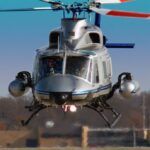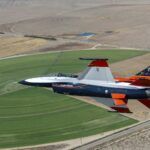Albright, D., S. Burkhard, and S. Faragasso. 2022. “Iranian Drones in Ukraine Contain Western Brand Components.” Institute for Science and International Security, October 31. https://isis-online.org/uploads/isis-reports/documents/Iranian_Drones_Contain_Western_Brand_Components_October31_FINAL.pdf
Allison, D. M., and S. Herzog. 2019. “5 Reasons Why the Saudi Oil Attacks Won’t Lead to War with Iran.” The National Interest, September 19. https://nationalinterest.org/feature/5-reasons-why-saudi-oil-attacks-won%E2%80%99t-lead-war-iran-82096
Altman, H., S. Payne, and T. Rogoway. 2022. “Ukraine Unleashes Mass Kamikaze Drone Boat Attack on Russia’s Black Sea Fleet Headquarters.” The Drive, October 29. https://www.thedrive.com/the-war-zone/ukraine-unleashes-mass-kamikaze-drone-boat-attack-on-russias-black-sea-fleet-headquarters
Bendett, S. 2022. “Where Are Russia’s Drones?” Defense One, March 1. https://www.defenseone.com/ideas/2022/03/where-are-russias-drones/362612/
Bollfrass, A. K., and S. Herzog. 2022. “The War in Ukraine and Global Nuclear Order.” Survival 64 (4): 7–32. doi: 10.1080/00396338.2022.2103255
Bremer, M. K., and K. A. Grieco. 2021. “The Air Littoral: Another Look.” Parameters 51 (4): 67–80. doi: 10.55540/0031-1723.3092.
Bronk, J., N. Reynolds, and J. Watling. 2022. “The Russian Air War and Ukrainian Requirements for Air Defense.” Royal United Services Institute, November 7. https://rusi.org/explore-our-research/publications/special-resources/russian-air-war-and-ukrainian-requirements-air-defense
Calcara, A., A. Gilli, M. Gilli, R. Marchetti, and I. Zaccagnini. 2022. “Why Drones Have Not Revolutionized War: The Enduring Hider-Finder Competition in Air Warfare.” International Security 46 (4): 130–171. doi: 10.1162/isec_a_00431.
Cole, C. 2022. “Armed Drones Proliferation Update.” Drone Wars, May 9. https://dronewars.net/2022/05/09/armed-drones-proliferation-update-may-2022/
Dass, R. 2022. “Militants and Drones: A Trend That is Here to Stay.” Royal United Services Institute, September 6. https://rusi.org/explore-our-research/publications/commentary/militants-and-drones-trend-here-stay
Deveraux, B. 2022. “Loitering Munitions in Ukraine And Beyond.” War on the Rocks, April 22. https://warontherocks.com/2022/04/loitering-munitions-in-ukraine-and-beyond/
Euronews. 2022. “Romania probes drone found on its territory days after crash in Croatia.” March 14. https://www.euronews.com/2022/03/14/romania-probes-drone-sighting-days-after-crash-in-croatia
The Economist. 2022. “Russia’s Terror Strikes Fail to Do Much damage to Ukraine.” October 13. https://www.economist.com/europe/2022/10/13/russias-terror-strikes-fail-to-do-much-damage-to-ukraine
Feldstein, S. 2022. “The Larger Geopolitical Shift Behind Iran’s Drone Sales to Russia.” Carnegie Endowment for International Peace, October 26. https://carnegieendowment.org/2022/10/26/larger-geopolitical-shift-behind-iran-s-drone-sales-to-russia-pub-88268
Gettinger, D. 2022. “Phoenix Ghosts are Part Drones, Part Missiles. How Does that Change Combat?” Bulletin of the Atomic Scientists, June 1. https://thebulletin.org/2022/06/phoenix-ghosts-are-part-drones-part-missiles-how-does-that-change-combat/
Gilli, A., and M. Gilli. 2016. “The Diffusion of Drone Warfare? Industrial, Organizational, and Infrastructural Constraints.” Security Studies 25 (1): 50–84. doi: 10.1080/09636412.2016.1134189.
Hall, R. C. 2014. “Reconnaissance Drones: Their First Use in the Cold War.” Air Power History 61 (3), 20–27. http://www.jstor.org/stable/26276490
Helfrich, E. 2022. “Rotax Engine Found in Iranian Mohajer-6 Drone Downed Over Ukraine.” The Drive, October 24. https://www.thedrive.com/the-war-zone/rotax-engine-found-in-iranian-mohajer-6-drone-downed-over-ukraine
Hird, K., K. Lawlor, G. Mappes, G. Barros, and M. Clark. 2022. “Russian Offensive Campaign Assessment, October 18.” Institute for the Study of War. https://www.understandingwar.org/sites/default/files/Russian%20Offensive%20Campaign%20Assessment%2C%20October%2018.pdf
Jennings, G. 2022. “Germany to Arm UAVs.” Janes, April 7. https://www.janes.com/defence-news/news-detail/germany-to-arm-uavs
Kallenborn, Z. 2021. “Swarm Talk: Understanding Drone Typology.” Modern War Institute, West Point, October 12. https://mwi.usma.edu/swarm-talk-understanding-drone-typology/
Kimball, D. G. 2020. “U.S. Reinterprets MTCR Rules.” Arms Control Today 50 (7): 32–33.
Kofman, M. 2020. “A Look at the Military Lessons of the Nagorno-Karabakh Conflict.” Russia Matters, Belfer Center for Science and International Affairs, Harvard Kennedy School, December 14. https://www.russiamatters.org/analysis/look-military-lessons-nagorno-karabakh-conflict
Kunertova, D. 2021. “European Drone Clubs Stall Strategic Autonomy.” Center for Security Studies, Policy Perspective 9 (5). doi: 10.3929/ethz-b-000477050.
Kunertova, D. 2022. “Ukraine War: Iranian ‘Kamikaze’ Drones Can Inflict Serious Damage But Will Not be a Gamechanger.” The Conversation, October 19. https://theconversation.com/ukraine-war-iranian-kamikaze-drones-can-inflict-serious-damage-but-will-not-be-a-gamechanger-192754?utm_source=linkedin&utm_medium=linkedinbutton
Kunertova, D., N. Masuhr, and C. Despont. 2022. “Militärische Drohnennutzung: Erfahrungen, Technologie und Schweizer Optionen” [Military Drone Use: Experiences, Technology and Swiss Options] in: Thränert, Oliver; Merz, Fabien; Kamasa, Julian (eds.), Bulletin 2022 zur schweizerischen Sicherheitspolitik [Bulletin 2022 on Swiss Security Policy], Center for Security Studies, ETH Zürich: 31–61. https://css.ethz.ch/content/dam/ethz/special-interest/gess/cis/center-for-securities-studies/pdfs/Bulletin_2022_05.pdf
NATO. 2022. “NATO Steps Up Support for Ukraine, Strengthens Deterrence and Defense.” October 13. https://www.nato.int/cps/en/natohq/news_208101.htm
NATO. 2017. “STANAG 4671 – Unmanned Aircraft Systems Airworthiness Requirements, Annex A.” February.
Page, J. M. 2022. “Drones in Ukraine: Claims, Concerns and Implications.” Royal United Services Institute, June 10. https://www.rusi.org/explore-our-research/publications/rusi-newsbrief/drones-ukraine-claims-concerns-and-implications
Rogers, J., and D. Kunertova. 2022. “The Vulnerabilities of the Drone Age Established Threats and Emerging Issues out to 2035.” NATO, Science for Peace and Security. https://css.ethz.ch/content/dam/ethz/special-interest/gess/cis/center-for-securities-studies/pdfs/NATO_VDA_Policy_Report.pdf
Rogers, J. 2021. “Future Threats: Military UAS, Terrorist Drones, and the Dangers of the Second Drone Age.” In A Comprehensive Approach to Countering Unmanned Aircraft Systems, edited by M. Willis, A. Haider, D. C. Teletin, and D. Wagner, 481–505. Kalkar, Germany: NATO Joint Air Power Competence Centre. https://www.japcc.org/wp-content/uploads/A-Comprehensive-Approach-to-Countering-Unmanned-Aircraft-Systems.pdf
Rogoway, T. 2022. “Ukraine Situation Report: Shadowy Long-Range Kamikaze Drone Strikes Again.” The Drive, August 20. https://www.thedrive.com/the-war-zone/ukraine-situation-report-shadowy-long-range-kamakaze-drone-strikes-again
Said, S., J. Malsin, and J. Donati. 2019. “U.S. Blames Iran for Attack on Saudi Oil Facilities.” Wall Street Journal, September 14. https://www.wsj.com/articles/drone-strikes-spark-fires-at-saudi-oil-facilities-11568443375
Scharre, P. 2014. “Robotics on the Battlefield Part II: The Coming Swarm.” Center for a New American Security, October 15. https://s3.us-east-1.amazonaws.com/files.cnas.org/documents/CNAS_TheComingSwarm_Scharre.pdf?mtime=20160906082059&focal=none
Shaikh, S., and W. Rumbaugh. 2020. “The Air and Missile War in Nagorno-Karabakh: Lessons for the Future of Strike and Defense.” Center for Strategic and International Studies, December 8. https://www.csis.org/analysis/air-and-missile-war-nagorno-karabakh-lessons-future-strike-and-defense
Seligman, L. 2022. “‘Huge problem’: Iranian drones pose new threat to Ukraine.” Politico, September 26. https://www.politico.com/news/2022/09/26/iranian-drones-ukraine-russia-war-00058802
Trofimov, Y., and D. Nissenbaum. 2022. “Russia’s Use of Iranian Kamikaze Drones Creates New Dangers for Ukrainian Troops.” Wall Street Journal, September 17. https://www.wsj.com/articles/russias-use-of-iranian-kamikaze-drones-creates-new-dangers-for-ukrainian-troops-11663415140
Watling, J., and N. Reynolds. 2022. “Ukraine at War Paving the Road from Survival to Victory.” Royal United Services Institute, Special Report, July 4. https://static.rusi.org/special-report-202207-ukraine-final-web_0.pdf
Willett, Marcus. 2022. “The Cyber Dimension of the Russia–Ukraine War.” Survival 64 (5): 7–26. Doi: 10.1080/00396338.2022.2126193.
Zanotti, J., and C. Thomas. 2022. “Turkey: Background and U.S. Relations In Brief.” Congressional Research Service, CRS Report for Congress, R44000, August 5. https://crsreports.congress.gov/product/pdf/R/R44000





















